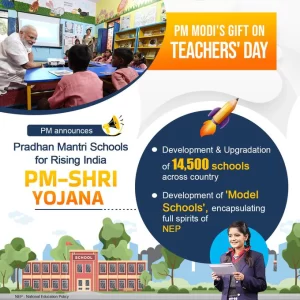14 Sep PM-SHRI Yojana
Announces PM-SHRI Yojana
Development and Upgradation of 14,500 schools across India under the Pradhan Mantri Schools For Rising India (PM-SHRI) Yojana
Why in News: On the occasion of Teacher’s Day today, the Prime Minister, Shri Narendra Modi has announced the development and upgradation of 14,500 schools across India under the Pradhan Mantri Schools For Rising India (PM-SHRI) Yojana.

PM SHRI Yojana
The PM-SHRI schools will have a modern, transformational and holistic method of imparting education. Shri Modi said that he is certain that the PM-SHRI schools will further benefit lakhs of students across India in the spirit of NEP.
The Prime Minister tweeted; “Today, on #TeachersDay I am glad to announce a new initiative – the development and upgradation of 14,500 schools across India under the Pradhan Mantri Schools For Rising India (PM-SHRI) Yojana. These will become model schools that will encapsulate the full spirit of NEP.”
“The PM-SHRI schools will have a modern, transformational and holistic method of imparting education. Emphasis will be on a discovery-oriented, learning-centric way of teaching. The focus will also be on modern infra including the latest technology, smart classrooms, sports, and more.”
“The National Education Policy has transformed the education sector in recent years. I am certain that the PM-SHRI schools will further benefit lakhs of students across India in the spirit of NEP.” These will become model schools that will encapsulate the full spirit of NEP.
In News
The Prime Minister has announced that under the PM SHRI Scheme, as many as 14,500 schools will be “upgraded” across India to showcase the components of the National Education Policy, 2020.
What is the PM SHRI scheme?
- 14,500 schools across states and Union Territories will be redeveloped to reflect the key features of the NEP, 2020 under the centrally sponsored scheme known as PM SHRI Schools (PM Schools for Rising India).
- The plan was first discussed with the education ministers of states and UTs during a conference organized by the Ministry of Education in June at Gandhinagar in Gujarat.
- While there are exemplary schools like Navodaya Vidyalayas and Kendriya Vidyalayas, the PM SHRI will act as “NEP labs”.
Features of NEP in school education
- The NEP envisages a curricular structure and teaching style divided into various stages – foundational, preparatory, middle, and secondary.
- The foundational years (preschool and grades I, II) will involve play-based learning.
- At the preparatory level (III-V), light textbooks are to be introduced along with some formal classroom teaching.
- Subject teachers are to be introduced at the middle level (VI-VIII).
- The secondary stage (IX-XII) will be multidisciplinary in nature with no hard separation between arts and sciences or other disciplines.
How will PM SHRI schools be different from Kendriya Vidyalayas or Jawahar Navodaya Vidyalayas?
- Kendriya Vidyalayas or Jawahar Navodaya Vidyalayas come entirely under the Center’s Ministry of Education and are fully funded by the Union government under Central Sector Schemes.
- While KVs largely cater to children of Union government employees posted in states and UTs, JNVs were set up to nurture talented students in rural parts of the country.
- In contrast, PM SHRI schools will be an upgrade of existing schools run by the Center, states, UTs, and local bodies.
- This essentially means that PM SHRI schools can either be KVs, JNVs, state government schools or even those run by municipal corporations.
Where will the PM SHRI schools come up?
- The Center has not yet released the list of schools that have been chosen for this purpose though it has been announced that the PM SHRI schools will also “offer mentorship” to other schools in their vicinity.
- These schools will be equipped with modern infrastructure including labs, smart classrooms, libraries, sports equipment, art room, etc.
- It shall also be developed as a green school with water conservation, waste recycling, energy-efficient infrastructure, and integration of an organic lifestyle in the curriculum.
What is a Centrally Sponsored Scheme?
- A centrally sponsored scheme is one where the cost of implementation is likely to split in the 60:40 ratio among the Union government and the states/Union Territories.
- For instance, the mid-day meal scheme (PM Poshan) or the PM Awas Yojana are examples of centrally sponsored schemes.
- In the case of the Northeastern states, Himachal Pradesh, Uttarakhand, Jammu and Kashmir, and UTs without legislatures, the Centre’s contribution can go up to 90 percent.
Source:
Download PDF now:
Get the best daily current affairs for the UPSC examination from Plutus IAS. It is one of the best coaching centers for PSIR optional. Also, read weekly, and monthly current affairs for IAS exam preparation.




No Comments